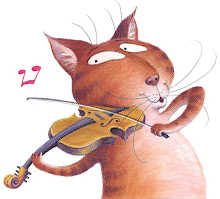Roosters are great aren't they? I love the arrogant way they move. Spot the very cute bunny too...
 Since I draw so many animals in my picture books, I thought you might like to see some real animal sketches.
Since I draw so many animals in my picture books, I thought you might like to see some real animal sketches.  I have always enjoyed the challenge of drawing animals. I sometimes visit a local city farm to sketch. They rarely keep still for long, so you have to be really quick and work on several drawings at once on the same page. You can see various false starts on this pig page:
I have always enjoyed the challenge of drawing animals. I sometimes visit a local city farm to sketch. They rarely keep still for long, so you have to be really quick and work on several drawings at once on the same page. You can see various false starts on this pig page:
 Here's some rather festive turkeys, and a goose or two. At least these ones are not for eating!
Here's some rather festive turkeys, and a goose or two. At least these ones are not for eating!  When I was in Namibia, we visited a cheetah sanctuary, which was a wonderful opportunity to draw a creature you wouldn't otherwise get close to.
When I was in Namibia, we visited a cheetah sanctuary, which was a wonderful opportunity to draw a creature you wouldn't otherwise get close to.  For many years cheetahs have been shot by Namibian farmers, frightened for their livestock. The Cheetah Conservation Centre is trying to persuade farmers to trap them instead, so that they can be released in another area.
For many years cheetahs have been shot by Namibian farmers, frightened for their livestock. The Cheetah Conservation Centre is trying to persuade farmers to trap them instead, so that they can be released in another area.  The cheetahs here were taken in as orphaned pups, unable to survive in the wild. Their enclosure is a large area and they seem happy enough, but cannot be released, as they have no hunting skills.
The cheetahs here were taken in as orphaned pups, unable to survive in the wild. Their enclosure is a large area and they seem happy enough, but cannot be released, as they have no hunting skills.  Possibly the most special animals I encountered in Namibia were the elephants. They were very graceful and almost silent, despite their size. They visited the waterhole, moving extremely slowly. Every so often they would freeze, spending several minutes at a time catnapping on their feet.
Possibly the most special animals I encountered in Namibia were the elephants. They were very graceful and almost silent, despite their size. They visited the waterhole, moving extremely slowly. Every so often they would freeze, spending several minutes at a time catnapping on their feet.  Giraffes were always very timid and would spend some considerable time dithering at waterholes worried about predators, before drinking. This is because they have to get into a very odd and vulnerable position in order to drink, splaying their front legs out at an extreme angle.
Giraffes were always very timid and would spend some considerable time dithering at waterholes worried about predators, before drinking. This is because they have to get into a very odd and vulnerable position in order to drink, splaying their front legs out at an extreme angle.  Namibia reserves are full of a variety of different deer-like animals. You can tell the difference by their horn shape, their markings and their size. Here some kudos. The male has these dramatic wavy horns.
Namibia reserves are full of a variety of different deer-like animals. You can tell the difference by their horn shape, their markings and their size. Here some kudos. The male has these dramatic wavy horns.  The female below is very much like a female deer, but stripy not spotty. Here are some impala as well. Impala have cute black dots on their ears, and slightly different shaped horns.
The female below is very much like a female deer, but stripy not spotty. Here are some impala as well. Impala have cute black dots on their ears, and slightly different shaped horns.  Another similar creature is the oryx, with these very long, straight horns. They like to wade and swim in the waterholes.
Another similar creature is the oryx, with these very long, straight horns. They like to wade and swim in the waterholes.  By far the most common though is the springbok. You see these everywhere, both inside and outside the reserves. They are the equivalent of pigeons in Britain. They are pretty cute. Their name comes from the fact that they actually do 'spring', just like new lambs!
By far the most common though is the springbok. You see these everywhere, both inside and outside the reserves. They are the equivalent of pigeons in Britain. They are pretty cute. Their name comes from the fact that they actually do 'spring', just like new lambs!

One day I came across these little, banded mongooses on our camp site, digging holes. They were making sweet little squeaking calls to each other. They gradually moved along together, digging all the while and I followed them, drawing.

Here are some ostriches, with their chunky thighs, and a kori bustard. We had guides who were excellent for identifying everything. One day an ostrich raced our truck. They go like the wind - those thighs are pure muscle!

Wildebeest are an unusual shape to draw: so top-heavy with quite little bums. They were around quite a lot, moving in small herds. I had to concentrate hard to get the shape right.
 I was fascinated by the zebras. Their markings were so bold and graphic, they really didn't look natural.
I was fascinated by the zebras. Their markings were so bold and graphic, they really didn't look natural.  I really loved their short, thick manes: like stripy mohicans!
I really loved their short, thick manes: like stripy mohicans! 
You can see more of my sketches from Namibia on my website including the sketchbooks I brought back from my other travels, like China, Vietnam, Australia and countries all over Europe.






 Since I draw so many animals in
Since I draw so many animals in  I have always enjoyed the challenge of drawing animals. I sometimes visit a local city farm to sketch. They rarely keep still for long, so you have to be really quick and work on several drawings at once on the same page. You can see various false starts on this pig page:
I have always enjoyed the challenge of drawing animals. I sometimes visit a local city farm to sketch. They rarely keep still for long, so you have to be really quick and work on several drawings at once on the same page. You can see various false starts on this pig page:  Here's some rather festive turkeys, and a goose or two. At least these ones are not for eating!
Here's some rather festive turkeys, and a goose or two. At least these ones are not for eating!  When I was
When I was  For many years cheetahs have been shot by Namibian farmers, frightened for their livestock. The Cheetah Conservation Centre is trying to persuade farmers to trap them instead, so that they can be released in another area.
For many years cheetahs have been shot by Namibian farmers, frightened for their livestock. The Cheetah Conservation Centre is trying to persuade farmers to trap them instead, so that they can be released in another area.  The cheetahs here were taken in as orphaned pups, unable to survive in the wild. Their enclosure is a large area and they seem happy enough, but cannot be released, as they have no hunting skills.
The cheetahs here were taken in as orphaned pups, unable to survive in the wild. Their enclosure is a large area and they seem happy enough, but cannot be released, as they have no hunting skills.  Possibly the most special animals I encountered in Namibia were the elephants. They were very graceful and almost silent, despite their size. They visited the waterhole, moving extremely slowly. Every so often they would freeze, spending several minutes at a time catnapping on their feet.
Possibly the most special animals I encountered in Namibia were the elephants. They were very graceful and almost silent, despite their size. They visited the waterhole, moving extremely slowly. Every so often they would freeze, spending several minutes at a time catnapping on their feet.  Giraffes were always very timid and would spend some considerable time dithering at waterholes worried about predators, before drinking. This is because they have to get into a very odd and vulnerable position in order to drink, splaying their front legs out at an extreme angle.
Giraffes were always very timid and would spend some considerable time dithering at waterholes worried about predators, before drinking. This is because they have to get into a very odd and vulnerable position in order to drink, splaying their front legs out at an extreme angle.
 The female below is very much like a female deer, but stripy not spotty. Here are some impala as well. Impala have cute black dots on their ears, and slightly different shaped horns.
The female below is very much like a female deer, but stripy not spotty. Here are some impala as well. Impala have cute black dots on their ears, and slightly different shaped horns.





 I really loved their short, thick manes: like stripy mohicans!
I really loved their short, thick manes: like stripy mohicans! 


